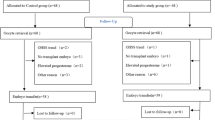Abstract
Purpose : The objective of this study was to compare the efficacy of GnRH-antagonists to GnRH-agonists in ovarian stimulation of poor responders undergoing IVF.
Methods : Retrospective analysis of our data revealed that 56 patients underwent treatment with a GnRH-agonist according to the flare-up protocol. Patients failing to achieve an ongoing pregnancy (n=53) were subsequently treated in the next cycle with a GnRH-antagonist according to the multiple-dose protocol. Main outcome measures included the clinical pregnancy and implantation rates.
Results : While ovulation induction characteristics and results did not differ between the two protocols, the number of embryos transferred was significantly higher (P=0.046) in the GnRH-antagonist than in the GnRH-agonist stimulation protocol (2.5 ± 1.6 vs. 2.0 ± 1.4, respectively). The clinical pregnancy and implantation rates per transfer in the GnRH-antagonist group appeared higher than in the GnRH-agonist, but did not differ statistically (26.1 and 10.7 compared with 12.2 and 5.9%, respectively). However, the ongoing pregnancy rate per transfer was statistically significantly higher (P=0.03) in the GnRH-antagonist than in the GnRH-agonist group (23.9 vs. 7.3%, respectively).
Conclusion : Applying GnRH-antagonists to ovarian stimulation protocols may offer new hope for IVF poor responder patients. However, further controlled randomized prospective studies with larger sample sizes are required to establish these results.
Similar content being viewed by others
REFERENCES
Pellicer A, Lightman A, Diamond MP, Russell JB, DeCherney AH: Outcome of in vitro fertilization in women with low response to ovarian stimulation. Fertil Steril 1987;47:812–815
Fasouliotis SJ, Simon A, Laufer N: Evaluation and treatment of low responders in assisted reproductive technology: A challenge to meet. J Assist Reprod Genet 2000;17:357–373
Schoolcraft W, Schlenker T, Gee M, Stevens J, Wagley L: Improved controlled ovarian hyperstimulation in poor responder in vitro fertilization patients with a microdose follicle-stimulating hormone flare, growth hormone protocol. Fertil Steril 1997;67:93–97
Surrey ES, Joann B, Hill DM, Ramsey J, Surrey MW: Clinical and endocrine effects of a microdose GnRH agonist flare regimen administered to poor responders who are undergoing in vitro fertilization. Fertil Steril 1998;69:419–424
Muasher SJ: Controversies in assisted reproduction: Treatment of low responders. J Assist Reprod Genet 1993;10:112–114
Leung PCK: GnRH receptor and potential action in human ovary. Gynecol Endocrinol 1999;13:10
Olivennes F, Alvarez S, Bouchard P, Fanchin R, Salat-Baroux J, Frydman R: The use of GnRH-antagonist (cetrorelix) in a single dose protocol in IVF-embryo transfer: A dose finding study of 3 versus 2 mg. Hum Reprod 1998;13:2411–2414
The Ganirelix Dose-Finding Study Group: A double-blind, randomized, dose-finding study to assess the efficacy of the gonadotropin-releasing hormone antagonist ganirelix (Org 37462) to prevent premature luteinizing hormone surges in women undergoing ovarian stimulation with recombinant follicle stimulating hormone (Puregon). Hum Reprod 1998;13:3023–3031
Ben-Rafael Z, Lipitz S, Bider D, Maschiach S: Ovarian hyporesponsiveness in combined gonadotropin-releasing hormone agonist and menotropin therapy is associated with low serum follicle-stimulating hormone levels. Fertil Steril 1991;55:272–275
Yang JH, Wu MY, Chao KH, Chen SU, Ho HN, Yang YS: Long GnRH-agonist protocol in an IVF program: Is it appropriate for women with normal FSH levels and high FSH/LH ratios? J Reprod Med 1997;42:663–668
Scott RT, Navot D: Enhancement of ovarian responsiveness with microdoses of gonadotropin-releasing hormone agonist during ovulation induction for in vitro fertilization. Fertil Steril 1994;61:880–885
Feldberg D, Fahri J, Ashkenazi J, Dicker D, Shalev J, Ben-Rafael Z: Minidose gonadotropin-releasing hormone agonist is the treatment of choice in poor responders with high follicle-stimulating hormone levels. Fertil Steril 1994;62:343–346
Faber BM, Mayer J, Cox B, Jones D, Toner JP, Oehninger S, Muasher SJ: Cessation of gonadotropin-releasing hormone agonist therapy combined with high-dose gonadotropin stimulation yields favorable pregnancy results in low responders. Fertil Steril 1998;69:826–830
Craft I, Gorgy A, Hill J, Menon D, Podsiadly B: Will GnRH-antagonists provide new hope for patients considered “difficult responders” to GnRH-agonist protocols? Hum Reprod 1999;14:2959–2962
Nikolettos N, Al-Hasani S, Felberbaum R, Demirel LC, Kupker W, Montzka P, Xia YX, Schopper B, Sturm R, Diedrich K: Gonadotropin-releasing hormone antagonist protocol: A novel method of ovarian stimulation in poor responders. Eur J Obstet Gynecol Reprod Biol 2001;97:202–207
Akman MA, Erden HF, Tosun SB, Bayazit N, Aksoy E, Bahceci M: Addition of GnRH-antagonist in cycles of poor responders undergoing IVF. Hum Reprod 2000;15:2145–2147
Akman MA, Erden HF, Tosun SB, Bayazit N, Aksoy E, Bahceci M: Comparison of agonistic flare-up protocol and antagonistic multiple dose protocol in ovarian stimulation of poor responders: Results of a prospective randomized trial. Hum Reprod 2001;16:868–870
Moreno C, Ruiz A, Simon C, Pellicer A, Remohi J: Intracytoplasmic sperm injection as a routine indication in low responder patients. Hum Reprod 1998;13:2126–2129
Palermo GD, Cohen J, Rosenwaks Z: Intracytoplasmic sperm injection: A powerful tool to overcome fertilization failure. Fertil Steril 1996;65:899–908
Ludwig M, Al-Hasani S, Kupker W, Bauer O, Diedrich K: A new indication for an intracytoplasmic sperm injection procedure outside the cases of severe male factor infertility. Eur J Obstet Gynecal Reprod Biol 1997;75:207–210
Author information
Authors and Affiliations
Rights and permissions
About this article
Cite this article
Fasouliotis, S.J., Laufer, N., Sabbagh-Ehrlich, S. et al. Gonadotropin-Releasing Hormone (GnRH)-Antagonist Versus GnRH-Agonist in Ovarian Stimulation of Poor Responders Undergoing IVF. J Assist Reprod Genet 20, 455–460 (2003). https://doi.org/10.1023/B:JARG.0000006707.88826.e7
Issue Date:
DOI: https://doi.org/10.1023/B:JARG.0000006707.88826.e7




